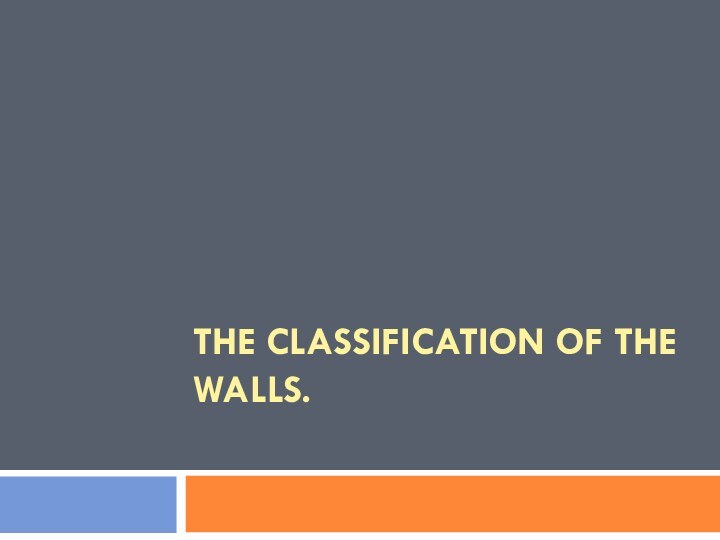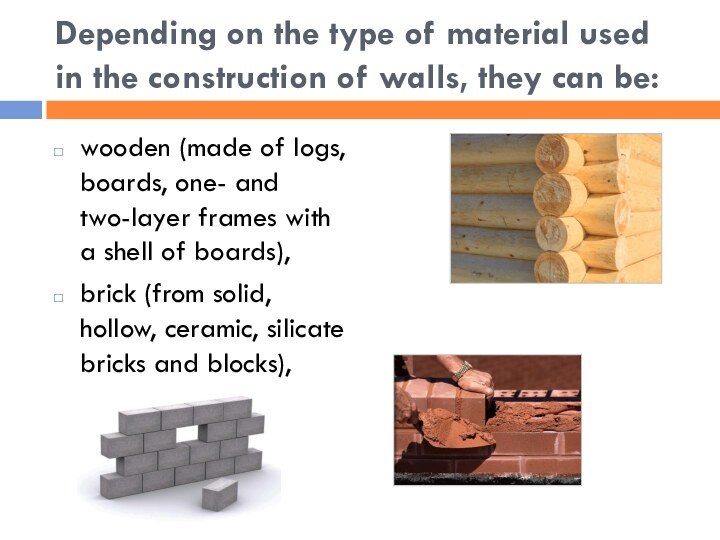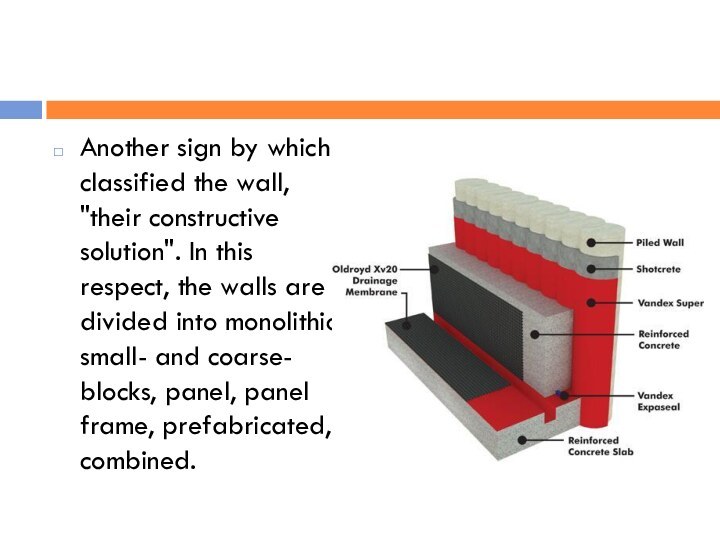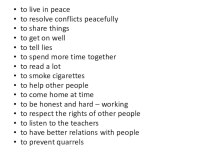- Главная
- Разное
- Бизнес и предпринимательство
- Образование
- Развлечения
- Государство
- Спорт
- Графика
- Культурология
- Еда и кулинария
- Лингвистика
- Религиоведение
- Черчение
- Физкультура
- ИЗО
- Психология
- Социология
- Английский язык
- Астрономия
- Алгебра
- Биология
- География
- Геометрия
- Детские презентации
- Информатика
- История
- Литература
- Маркетинг
- Математика
- Медицина
- Менеджмент
- Музыка
- МХК
- Немецкий язык
- ОБЖ
- Обществознание
- Окружающий мир
- Педагогика
- Русский язык
- Технология
- Физика
- Философия
- Химия
- Шаблоны, картинки для презентаций
- Экология
- Экономика
- Юриспруденция
Что такое findslide.org?
FindSlide.org - это сайт презентаций, докладов, шаблонов в формате PowerPoint.
Обратная связь
Email: Нажмите что бы посмотреть
Презентация на тему The classification of the walls
Содержание
- 2. The wall - the main elements of
- 3. In construction, depending on destination, the walls
- 4. Load-bearing wall is a natural continuation of
- 5. Non-bearing walls, the wall is a wall,
- 6. Good quality walls provide strength and stability, weather resistance, fire resistance, thermal and sound insulation.
- 7. Depending on the type of material used
- 8. stone (from cobble stone, limestone, limestone, tuff
- 9. All construction of wall can be divided
- 10. Monolithic wall, in which the wall is
- 11. Frame wall, in which the wall is
- 12. Membrane wall, in which the wall is
- 13. Another form of construction adapted for framed
- 14. When choosing the material for the erection
- 15. Скачать презентацию
- 16. Похожие презентации
The wall - the main elements of the design of the building, and on the choice of their type depend on many parameters of the future house: external or internal appeal, comfort, heat- and sound insulation,















Слайд 3 In construction, depending on destination, the walls are
divided into external and internal. In the perception of
loads walls are divided on the load-bearing and non-bearing.Слайд 4 Load-bearing wall is a natural continuation of the
foundation and is an essential element of the construction
of the building, it serves as a base for the beams or concrete tiles, ceiling or attic floors, that is, the "bears" on a kind of load. During the dismantling of the bearing wall violate the integrity of the building.Слайд 5 Non-bearing walls, the wall is a wall, the
main purpose of which is the separation of facilities
into several parts or allocation in the room of functional zones. Its removal does not entail a redistribution of loads in the construction of the building. Non-bearing walls, a wall or a partition can only be internal.Слайд 6 Good quality walls provide strength and stability, weather
resistance, fire resistance, thermal and sound insulation.
Слайд 7 Depending on the type of material used in
the construction of walls, they can be:
wooden (made of
logs, boards, one- and two-layer frames with a shell of boards),brick (from solid, hollow, ceramic, silicate bricks and blocks),
Слайд 8 stone (from cobble stone, limestone, limestone, tuff stone,
sandstone),
concrete (from heavy concrete of different grades - slabs
and blocks, as well as of lightweight concrete - cellular-concrete, claydite-owned, breeze, foam concrete, raspings-concrete blocks).Слайд 9 All construction of wall can be divided into
four main groups.
Masonry wall, in which the wall is
built of individual blocks of materials such as brick, clay or concrete blocks, or stone, usually in horizontal courses bonded together with some form of mortar. Several of the earth derived products, either air dried or fired, are reasonable in cost and well suited to the climate.Слайд 10 Monolithic wall, in which the wall is built
of a material placed in forms during the construction.
The traditional earth wall and the modern concrete wall are examples. The earth walls are inexpensive and durable if placed on a good foundation and protected from rain by a rendering or wide roof overhangs.Слайд 11 Frame wall, in which the wall is constructed
as a frame of relatively small members, usually of
timber, at close intervals which together with facing or sheething on one or both sides form a load-bearing system. Offcuts are a lowcost material to use for a frame wall covering.Слайд 12 Membrane wall, in which the wall is constructed
as a sandwich of two thin skins or sheets
of reinforced plastic, metal, asbestos-cement or other suitable material bonded to a core of foamed plastic to produce a thin wall element of high strength and low weight.Слайд 13 Another form of construction adapted for framed or
earth buildings consists of relatively light sheeting secured to
the face of the wall to form the enclosed element. These are generally termed 'claddings'.Factors which will determine the type of wall to be used are:The materials available at a reasonable cost.
Availability of craftsmen capable of using the materials in the best way.
Climate
The use of the building - functional requirements.





























